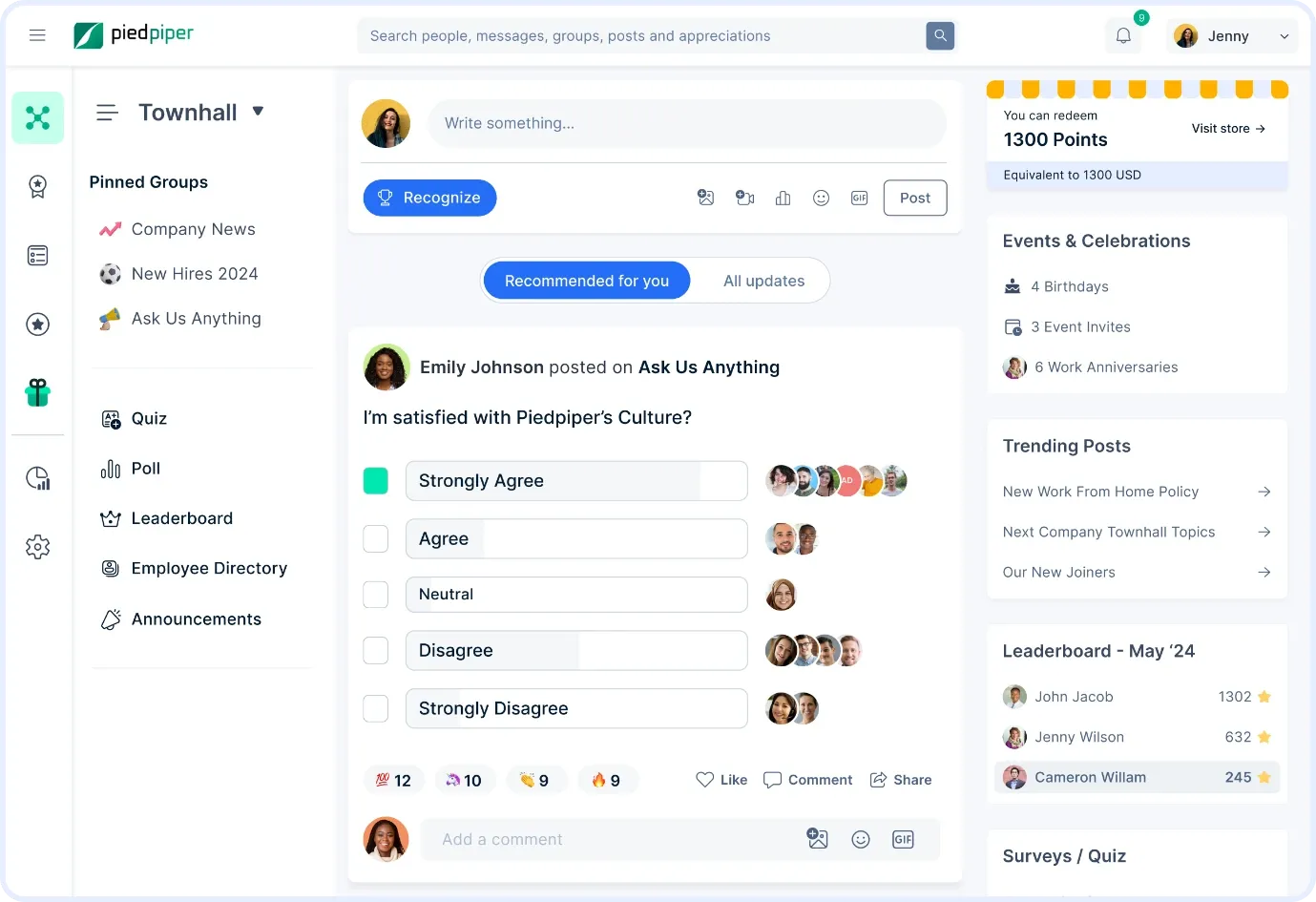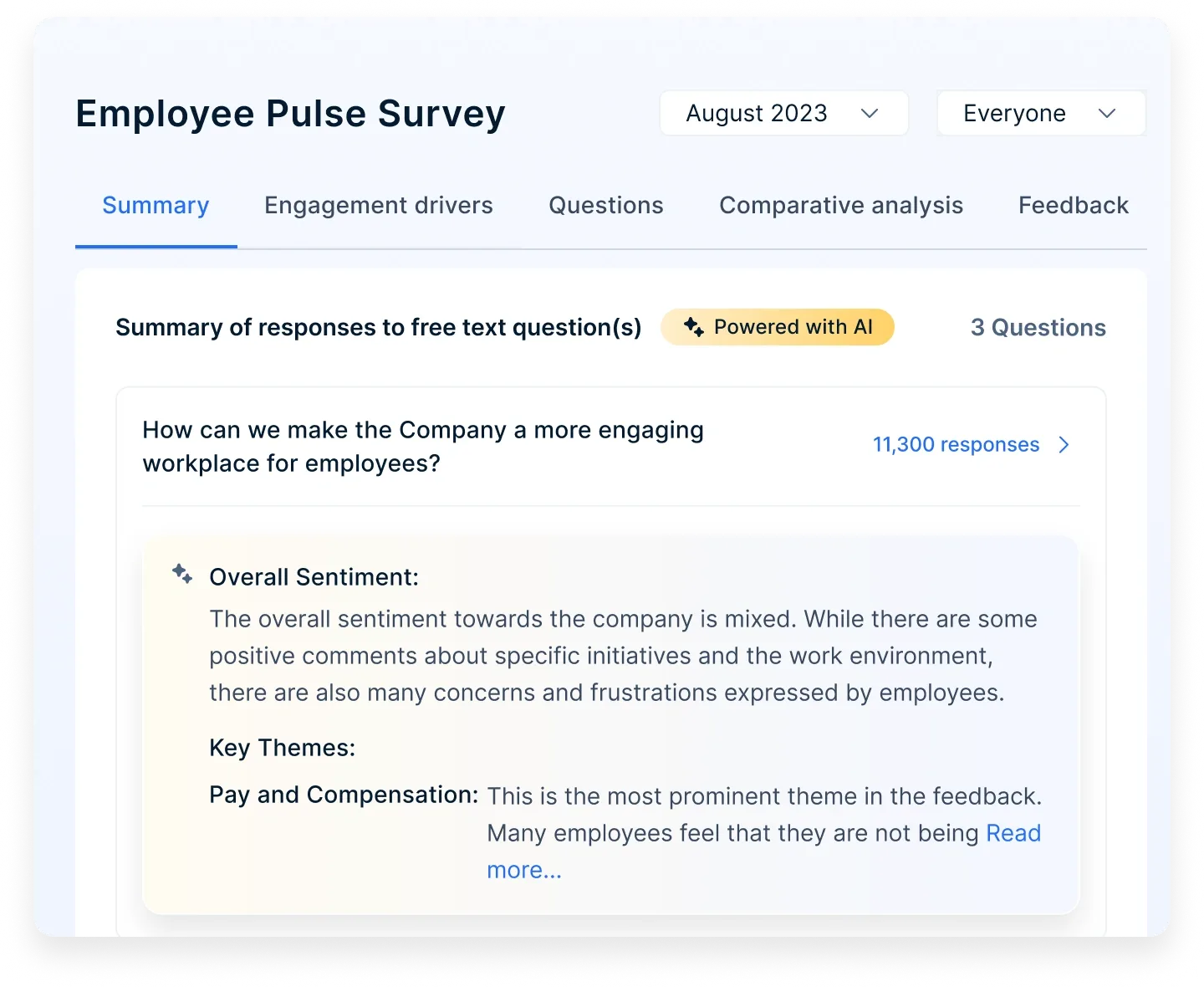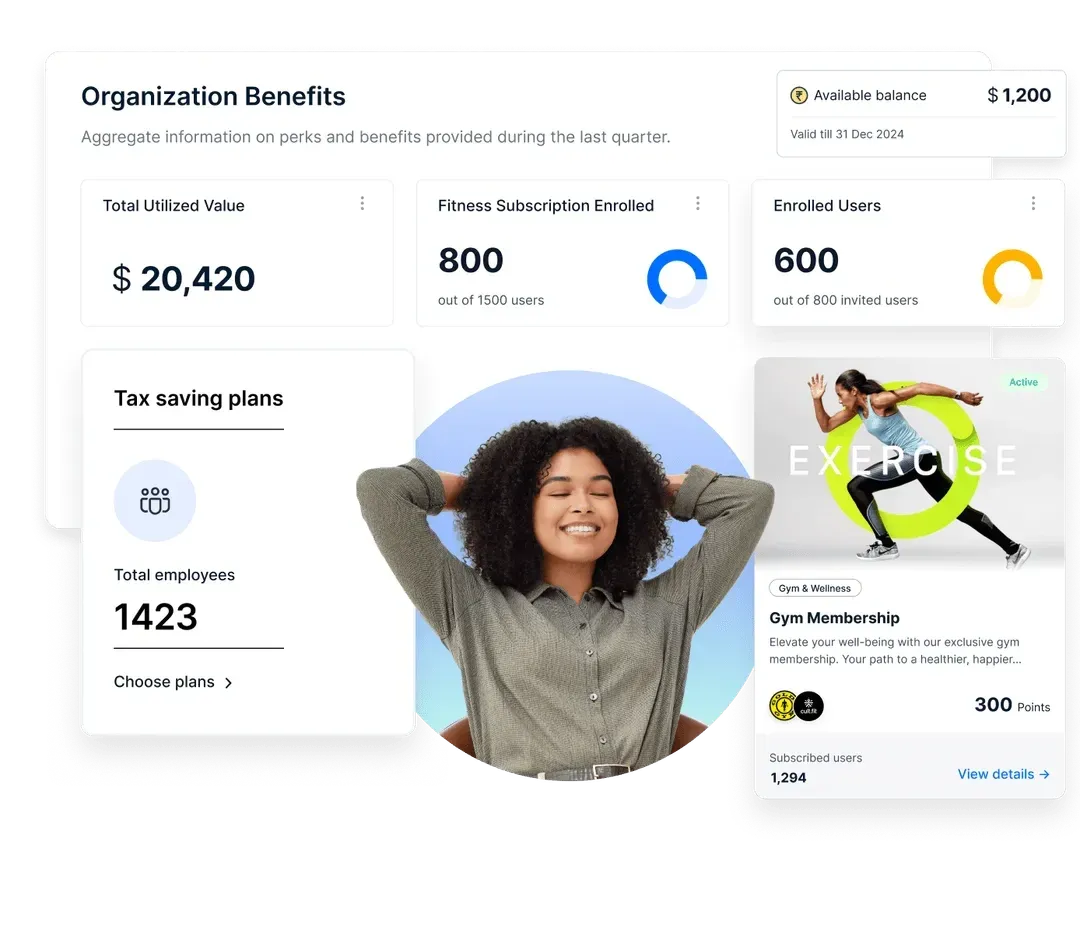How to Measure Employee Happiness: Proven Strategies, Methods and Tools
Learn how to measure employee happiness using surveys, feedback, and engagement strategies. Explore actionable tips to build a happy and high-performing workforce.
Auf dieser Seite
Today employee happiness has become more than just a feel-good concept—it’s a crucial driver of organizational success. Businesses that prioritize happiness in the workplace consistently report better performance, higher retention, and increased innovation.
But here's the challenge: while companies understand its importance, many still struggle with how to measure employee happiness effectively and implement actionable improvements.
With workplace happiness influencing everything from engagement to productivity, it’s time to decode what truly makes employees happy and explore proven strategies to both measure employee happiness and nurture it sustainably.
In this guide, we will walk you through measuring employee happiness, using tools like employee happiness surveys and the employee happiness index, and show how organizations can turn these insights into meaningful change.
What is employee happiness?
Mitarbeiterzufriedenheit bezeichnet die allgemeine Zufriedenheit und die Übereinstimmung der Erwartungen an die Arbeit mit der tatsächlichen Wahrnehmung.
Employees' happiness lies at the intersection of involvement and satisfaction. This is a quality of employee experience that is higher than employee satisfaction. It is one of the building blocks for attracting employees. Let's look at this question in more detail!
Satisfied employees 😌 perform well in their roles and have few complaints, but they can still explore other opportunities if presented with the options. The employees involved, in turn, regularly do more in their tasks than is usually required. They personally invest in the development of the company.
Loyalty to the business of such employees is very high. To reach this level, the organization needs the happiness of employees.
Employee happiness vs. job satisfaction
Employee happiness has tended to be talked about much less than job satisfaction in the business world. Therefore, there might be some confusion between these terms.
Besides, a comparable rarity of the term 'employee happiness' makes it seem like something difficult or impossible to achieve. However, this is not quite true.
Zunächst einmal sollten wir ein für alle Mal eine Grenze zwischen Arbeitszufriedenheit und Mitarbeiterzufriedenheit ziehen.
Employee happiness is often described as a constant positive attitude towards one's work. Besides, employee happiness also finds its representation in a strong motivation to solve problems rather than complain, willingly accept constructive criticism and improve one's knowledge and skills.
Satisfaction, as it is, means fulfillment and enjoyment a person drives from something. Job satisfaction, in its turn, is a measure of employee contentment with the job. This implies that the employees are satisfied at work as the work meets the expectations.
Die Hauptunterscheidungsmerkmale zwischen diesen beiden Begriffen liegen auf der Hand, werden aber von den Arbeitgebern oft missverstanden:
- Zufriedenheit ist immer das Ergebnis von etwas Erfülltem - einer abgeschlossenen Aufgabe oder einem erreichten Meilenstein. Im Gegensatz dazu ist Glück ein dauerhafter Zustand, der sich allmählich entwickelt.
- Es hat den Anschein, dass die Arbeitszufriedenheit der Arbeitnehmer hauptsächlich vom Arbeitgeber gesteuert wird, da sie weitgehend von Belohnungen, Anerkennung und der Vereinbarkeit von Beruf und Privatleben abhängt. Die Zufriedenheit der Arbeitnehmer hängt hingegen von den Arbeitnehmern selbst ab.
- Studies proved that happy employees are 13% more productive. At the same time, there is very little correlation between job satisfaction and productivity;
- Glück bei der Arbeit ist immer ein weiter gefasster Begriff, der das Gefühl umfasst, voller Energie zu sein, sich zu engagieren und, was noch wichtiger ist, zufrieden zu sein.
Es gibt Hunderte von Zahlen in vielen langen, gründlich dokumentierten Berichten, die versuchen, die praktischste und konkreteste Seite von Mitarbeiterzufriedenheit und -engagement zusammenzufassen. Allerdings gibt es hier keine Schwarz-Weiß-Definitionen.
Trotz der Zweideutigkeit der Begriffe können Unternehmen und Arbeitgeber die Situation klären, indem sie die Erkenntnisse der Verhaltenswissenschaften sammeln und kombinieren, die mehr Licht auf das "Warum" und "Wie" des Glücks für ihre Mitarbeiter werfen können.
Ways to create happiness in the workplace
Machen Sie Ihre Mitarbeiter, Vertriebsmitarbeiter, Vertriebskanäle, Netzwerke und erweiterten Teams mit diesen drei leistungsstarken Strategien glücklich.
1. Motivieren Sie sowohl extern als auch intern
‘Happiness Advantage’ author Shawn Achor describes happiness as “the joy we feel when striving for our potential.” This is squarely the preserve of intrinsic motivation - the inner impulses, talents, and passions that define our personalities and push us to chase targets that are often deeply personal.
Autonomie (die Freiheit zu denken, zu arbeiten und zu sein), die Beherrschung eines Bereichs oder einer Fähigkeit, für die man sich begeistert, und ein übergeordnetes Ziel oder eine Richtung im Leben sind die drei wichtigsten intrinsischen Motivationen der meisten Menschen.
Intrinsische Ziele sind in der Regel sozusagen ihre Belohnung, und wir verfolgen sie ausschließlich wegen der Befriedigung, die sie uns bringen, ohne uns allzu sehr darum zu kümmern, "was andere denken". Untersuchungen haben gezeigt, dass intrinsische Motive das Engagement der Mitarbeiter dreimal stärker beeinflussen können als extrinsische Motive.
Dies macht diese "selbstgesteuerten Auslöser für das Erreichen eines hohen Exzellenzniveaus" zu einem äußerst wirksamen und weitgehend unerforschten Instrument für ein Unternehmen, wenn es den Einsatz erhöhen und Sprünge in unbekannte Gebiete ohne Präzedenzfall oder Benchmark zur Orientierung unternehmen muss.
Kluge Führungspersönlichkeiten lassen dem Einzelnen den nötigen Spielraum, um solche Sprünge zu machen. Sie richten ihre Arbeitsplätze und Anreizmodelle so aus, dass sich die intrinsischen Triebkräfte des Einzelnen und die übergeordneten Unternehmensziele so weit wie möglich überschneiden, um letztere zu fördern.
According to a McKinsey study, intrinsically motivated employees exhibit 46% higher levels of job satisfaction and 32% greater levels of commitment to their jobs.
Dennoch lässt sich die Tatsache nicht leugnen, dass die meisten von uns ihr Glück nach wie vor täglich mit dem guten alten Geld "kaufen". Externe (extrinsische) Motivationen wie Bargeld, soziale Wertschätzung und materialistischer Genuss sind nach wie vor die immergrünen Triebfedern für "gewinnbringendes" Verhalten und die bevorzugten Mittel von Führungskräften, um die Macht der Menschen zu beschwören und Anreize zu schaffen.
↠ 46% of upper management in large-scale companies deems that incentive programs are an investment and not an expense.
↠ McLean & Company found that a disengaged employee costs an organization approximately $3,400 for every $10,000 in annual salary.
2. Sofortige und einprägsame Belohnung
Die jährlichen Umsatzsteigerungen sind bei Teams mit einem messbaren Anreizsystem dreimal höher als bei Teams ohne ein ähnliches Motivationsmodell.
There’s an ancient saying, “Pay the worker his dues before his sweat has dried up.” Mankind has known for ages that the joy of a reward is greatest when it exchanges hands quickly. The longer the delay, the more is lost–especially from the giver's perspective.
Die Moral lässt nach, die Dynamik schwindet, und es macht sich Unzufriedenheit breit. Den Führungskräften bleibt nur wenig übrig, um all die hervorragende Arbeit, die sie in den Bereichen Schulung, Engagement und Anreize geleistet haben, zu honorieren. Das Gegenteil ist ebenso der Fall.
↠ According to The Economic Times, 88% of employees want employers to reward them for great work.
↠ According to the same study, 47% of employees want to receive a personalized reward spontaneously.
↠ According to Think Smart, companies with incentive programs registered a 79% success rate when it comes to reaching goals when the correct reward was offered.
↠ According to Incentive Research Foundation (IRF), an intuitively incentive program has been proven to raise employee performance by up to 44%.
Wenn Sie sicherstellen, dass Ihre Belohnungen sofort, angemessen (d. h. dem Umfang der Leistung entsprechend) und personalisiert (d. h. auf die Persönlichkeit und den Wunschzettel des Empfängers abgestimmt) sind, kann dies ein einfacher und wirkungsvoller Weg sein, um das Beste aus den Mitarbeitern herauszuholen.
3. Gestaltung eines vernetzten Arbeitsplatzes
Das muntere Hin und Her von Smalltalk und wichtigem Feedback. Der freizügige Austausch von Ideen und Tipps. Der intuitive Anstoß und die Warnungen von Gleichgesinnten. Die Türen und Fenster der Dankbarkeit, die diskret und öffentlich geteilt werden, machen den Arbeitstag warm und lohnend.
Mitarbeiter, Kanäle und erweiterte Teams propagieren die Marke in den sozialen Medien. Die Loyalität der Mitarbeiter führt zu einer geringen Fluktuation im Team. Die "People Stories", die sich viral verbreiten, schaffen eine Art "Awesome Place To Work"-Buzz. Die Belohnungskultur geht über "nicht-persönliches Bargeld" hinaus und bietet mehr denkwürdige Gesten.
Wirklich zusammenhängende Arbeitsabläufe sind nicht schwer zu erkennen, ebenso wenig wie das Glück, das sie erzeugen, das leicht zu entdecken ist.
Amongst features that create an emotionally fulfilling place of work, according to this report, are:
- Ein klares Bild des Geschäftsverlaufs zu haben.
- Wertschätzung für die eigene Meinung und die eigenen Fähigkeiten.
- Wertschätzung - in Form von Anerkennung und Belohnung - als Gegenleistung für Beiträge und Leistungen.
Denken Sie jedoch daran, dass Sie regelmäßig Anstrengungen unternehmen müssen, um das Zugehörigkeitsgefühl" in die kulturellen Fasern und die DNA Ihres Arbeitsplatzes einzubetten und zu institutionalisieren, wenn Sie die Früchte der Arbeit ernten wollen.
4. Prioritize work-life balance
To start increasing the level of employee happiness, it is worth improving the balance between work and personal life because tired employees are more likely to become unmotivated and burn out faster.
Unfortunately, an imbalance between the workplace and personal life has a destructive outcome for the employees and considerable financial losses for the employers. Higher employee turnover reduced productivity, and low engagement levels, are just a few of the results unsuitable both for businesses and employees themselves.
According to Inc, unfortunately, 66% of full-time employees in America do not have a work-life balance, in contrast to an astonishing 84% of freelancers who are happy with their lifestyle.
5. Be transparent and honest
Um eine solide Unternehmenskultur aufzubauen, braucht man Vertrauen innerhalb des Unternehmens. Die Mitarbeiter wollen wissen, dass ihre Führungskräfte Menschen sind, die ihre Probleme verstehen, weil auch sie sie erlebt haben oder noch erleben.
When leaders are honest and open to their employees, there is sincere and genuine communication and complete trust. Unfortunately, a recent Interact/Harris Poll proved that 91% of employees believe their leaders to have at least some kind of communication skills lack.
Besides, one more vital factor to consider is a lack of trust. The Edelman Trust Barometer showed that 1 in 3 employees doesn’t trust their employers, while others have minor trust issues.
6. Schaffung eines positiven Arbeitsumfelds
Wenn Mitarbeiter als ein gut koordiniertes Team arbeiten und hohe gemeinsame Ziele anstreben, kommt das Unternehmen voran, wird stärker und gedeiht. Nehmen wir jedoch an, die Mitarbeiter sind gereizt, stehen sich feindselig gegenüber, geraten oft in Konflikt und wollen keine Anstrengungen unternehmen, um gemeinsame Ziele zu erreichen. In diesem Fall wirkt sich dies unweigerlich auf die Ergebnisse aus und verschlechtert die KPI des Unternehmens.
According to the evidence gained in course of major long-term study, companies with the best corporate cultures grew 682 percent in revenue. Typically, for these companies, encouragement of all-around leadership initiatives and high appreciation of their employees, and owners, are key elements of the corporate culture. Furthermore, the recipe is quite simple - use recognition and rewards to highlight people who display the right behaviors, actions, and performance.
7. Foster a culture of gratitude
You can boost employee morale by showing them how valuable their efforts are to you through words and actions of gratitude. After all, even small things like that can make a big difference to your employees.
Unfortunately, according to a Gallup poll, only 14 % of employees worldwide are engaged at work. The remaining 86 % don’t feel valued or appreciated and don’t feel that their work is recognized.
8. Offer benefits beyond the basics
Many businesses offer employee benefits, and many employees expect them to reward employees with more than just money. Of course, few people will refuse a salary increase. But not all problems can be solved with money, especially regarding physical and mental well-being. In this case, an alternative solution will work much better.
When an employee does a good job, you can reward them with additional vacation, tickets for concerts or sports matches, or gift certificates. Thus, according to a recent survey, 79% of millennials regard an increase in rewards as a factor that would increase their loyalty to an employer to some extent.
Ein gutes Sozialleistungsprogramm hilft Ihnen daher, die besten Mitarbeiter zu gewinnen und zu halten, führt zu zufriedeneren und produktiveren Mitarbeitern und kann letztlich zum Erfolg Ihres Unternehmens beitragen.
9. Empower professional growth
Employees want to learn, evolve, and feel that they are progressing. Offering clear career paths, access to training, mentorship programs, and stretch projects keeps teams inspired.
A lack of growth opportunities is one of the top reasons people leave jobs. Investing in development helps both retention and workplace happiness, while also giving clear metrics to measure employee happiness through satisfaction scores and career progression tracking.
10. Support mental health and well-being
Modern employees expect more than just gym discounts—they want real mental health support. Counseling access, stress management workshops, and digital wellness apps can create lasting change.
Happier employees take fewer sick days and remain more productive.
11. Conduct regular employee happiness surveys
You can't improve what you don't measure. Regular employee happiness surveys provide quantifiable insights into how employees feel, what motivates them, and where to improve.
These tools offer direct ways to track the employee happiness index, enabling data-backed changes that reflect real employee sentiment. It's one of the most effective answers to the question: how to measure employee happiness.
12. Recognize purpose-driven work
When people understand how their efforts contribute to the bigger picture, their sense of purpose grows—and with it, their happiness.
Leaders should communicate how individual roles align with company impact, especially in mission-driven industries. This alignment not only uplifts morale but serves as a strong parameter to measure employee happiness based on engagement levels.
13. Facilitate meaningful one-on-ones
One-on-one meetings shouldn't be checklist routines. Instead, make them spaces for mentorship, feedback, and empathy.
Consistent, meaningful check-ins help employees feel heard, supported, and valued. When designed thoughtfully, they provide anecdotal insights into measuring employee happiness beyond traditional surveys.
14. Celebrate milestones and achievements
Birthdays, work anniversaries, and project completions deserve celebration. Recognizing these moments builds community and fosters pride.
These celebrations can be tracked and personalized, offering both joy and touchpoints to measure employee happiness in ways that are emotionally significant and impactful.
15. Encourage peer-to-peer recognition
Recognition doesn’t have to come from the top down. Platforms that enable colleagues to praise one another create a culture of inclusion and support. Peer-to-peer recognition builds camaraderie and spreads positivity.
Summary of key modules to use in Empuls:
Strategie | Empuls Features to Use |
Measure Happiness | eNPS, pulse surveys, EX lifecycle surveys |
Motivate | R&R engine, global reward catalog, AI-powered recognition |
Connect Teams | Social intranet, community groups, wishboards |
Encourage Wellness | Perks & benefits, flexible fringe benefits, salary advances |
Promote Growth | Learning rewards, performance-based incentives |
Build Trust | Transparent communications, AMAs, leader-led posts |
Foster Belonging | Peer recognition, milestone celebrations, inclusive programs |
How to measure employee happiness while identifying unhappiness?
How to measure the happiness of employees, then? This is the central question of all caring company leaders. Foremost, measuring happiness at work can be pretty tricky, but it is essential always to keep trying. Over time, it will become clear what indicators of employee happiness are worth paying attention to. This will make the process more intuitive and easier.
Im Folgenden werden die besten Methoden und Ansätze zur Messung des Glücks am Arbeitsplatz vorgestellt.
1. Umfrage zur Mitarbeiterzufriedenheit
Special surveys can be used to identify the level of happiness of employees. They can also be used to assess the level of employee satisfaction with their role and their level of involvement in the company and overall well-being.
After collecting data with their help, it is easy to identify any potential problems and critical areas for improving the condition of employees.
Since employees may change periodically, such employee happiness and engagement surveys should be conducted regularly. Alternatively, you can send surveys throughout the company several times a year. For more accurate results, combining the survey with other methods of measuring happiness is recommended.
2. Anonyme Feedback-Möglichkeiten für Mitarbeiter
Seeking your employees' feedback is essential for efficient business functioning. Unfortunately, according to recent research, 36% of employees work at a company that doesn't have a feedback program in place, while 37% report that their workplace either doesn't have an open-door policy or it has one, but it isn't working properly.
Dies erschwert es den Mitarbeitern, der Unternehmensleitung ihr Feedback zu geben, und lässt sie glauben, dass ihre Meinung nicht geschätzt wird. Die Zufriedenheit der Mitarbeiter hängt wesentlich mit ihrem Gefühl zusammen, an ihrem Arbeitsplatz wichtig und nützlich zu sein.
Furthermore, the ultimate aim of any employee feedback is for an employer to discover the state of their workplace culture and where they're succeeding or failing in terms of engagement and morale.
3. Häufige 1-zu-1-Gespräche und 2-Wege-Feedback
One-on-one interviews and performance tests help contextualize your employees' responses to surveys. With the help of interviews, you can get good employee feedback. According to SHRM research, peer-to-peer recognition is 35.7% more likely to impact financial results than manager-only recognition positively. Still, a personal conversation with each of them has additional benefits in the fight for colleagues' happiness.
Optimal ist es, solche Gespräche alle zwei Wochen zu führen. Um dafür Zeit einzuplanen, sollten Sie natürlich Ihren Arbeitsplan überprüfen, aber ein Beispiel für ein 30-minütiges Gespräch kann ein guter Anfang sein.
4. Leistungskontrollen der Mitarbeiter
Die Taten der Mitarbeiter sagen mehr als ihre Worte. Manchmal sagen auch anonyme Umfragen nicht die ganze Wahrheit. Eine aussagekräftigere Methode, um herauszufinden, ob Mitarbeiter ausgebrannt sind, besteht darin, zu prüfen, wie konsistent die Leistung jedes Einzelnen ist, wie hoch die Fehlzeiten, die Mitarbeiterbindung oder die Personalfluktuation sind, sowie die Einstellungsdaten und den allgemeinen Ruf des Unternehmens zu überprüfen.
Verwenden Sie auch alle Ihnen zur Verfügung stehenden Messgrößen wie Leistung, Arbeitsqualität, Fehler und Geschwindigkeit der Projektabwicklung und des Abschlusses. Der Grad der Zufriedenheit der Mitarbeiter zeigt, dass jeder Einzelne tief in die Produktivität eintaucht.
5. Überwachung des Wohlbefindens der Mitarbeiter
Einer der Faktoren, die das Glück der Mitarbeiter beeinträchtigen, ist Stress. Jede Führungskraft muss in die Gesundheit ihrer Mitarbeiter investieren, damit sie in Zukunft nicht die Folgen von Burnout und geringer Zufriedenheit ernten.
According to recent research, 79% of American employers carefully provide health programs to their employees. However, employees must have the necessary resources to care for their well-being. This is one aspect of increasing staff retention.
When interviewing employees about their health, you should ask them to assess their condition. Employees' productivity and well-being help form a stable, engaged, and hard-working workforce.
6. Gespräche über den Verbleib und das Ausscheiden von Mitarbeitern
Die besten Manager und Arbeitgeber sehen nicht stillschweigend zu, wie ihre Mitarbeiter aus der Tür gehen, sondern führen proaktiv Gespräche und diskutieren, was in ihren Unternehmen funktioniert und was nicht.
Umfragen zeigen, dass der Hauptgrund für die Abwanderung von Mitarbeitern nicht die Arbeit und nicht einmal der Gehaltsscheck ist, sondern die Beziehung der Mitarbeiter zu ihren Vorgesetzten und Kollegen. Die Kosten für den Aufbau einer gesunden Beziehung am Arbeitsplatz scheinen also nichts zu sein im Vergleich zu den Kosten der Fluktuation, wenn talentierte Mitarbeiter gehen.
Einer der größten Fehler, den Führungskräfte häufig begehen, ist die Annahme, dass ein Teammitglied bei der Arbeit glücklich ist, weil es sich nicht beschwert. Natürlich mag die Frage nach der Zufriedenheit bei einem Gespräch über den Aufenthalt oder den Austritt eines Mitarbeiters lächerlich erscheinen. Dennoch kann und wird es einen Unterschied in der Beziehung zum Rest der Mannschaft und zu den zukünftigen Mitarbeitern machen.
“You can’t improve what you don’t measure.” Here are the top tools and techniques to measure happiness at work:
Method | Empuls solution |
Employee happiness surveys | eNPS, pulse, and lifecycle surveys |
Anonymes Feedback | 360° feedback and polls |
1-on-1 conversations | Smart AI nudges and conversation prompts |
Performance analytics | Dashboard insights and engagement heatmaps |
Wellness tracking | Usage of perks, fringe benefits, and stress indicators |
Exit and stay interviews | Feedback loops throughout the employee lifecycle |
Empower employee engagement with Empuls: Your all-in-one solution
Empuls is an AI-powered, all-in-one employee engagement platform that helps organizations connect, recognize, and support their workforce across the entire employee lifecycle.
1. Connect employees to your company’s culture and vision

Empuls makes it easy to align teams with business goals through a modern social intranet that promotes inclusive, transparent communication. Share updates, celebrate wins, and foster a sense of belonging with:
- Townhall pages, polls, and announcements
- Community and hobby groups
- Wishboards for birthdays, milestones, and service anniversaries
- Interactive content like GIFs, hi-fives, and AMAs
2. Listen to employees and take meaningful action

Empuls provides powerful employee listening tools, including:
- eNPS and pulse surveys to measure engagement levels
- Lifecycle surveys for key moments like onboarding and exit
- 360° feedback for candid peer and manager evaluations
- AI-powered analytics to help HR and leaders make data-driven decisions
Use these insights to build a people-first culture and improve workplace experience.
3. Recognize and reward in the moments that matter

Empuls turns everyday accomplishments into moments of recognition. With automated workflows and smart nudges from Em, the AI assistant, managers and peers can:
- Send in-the-moment recognitions
- Celebrate birthdays, work anniversaries, and milestones
- Launch structured reward programs—spot awards, jury-based, or peer-to-peer
- Manage budgets and rewards centrally
With a global catalog of 1M+ reward options—from gift cards and experiences to Amazon merchandise and charity donations—there’s something for everyone.
4. Elevate employee well-being with perks and benefits

Empuls goes beyond rewards by offering comprehensive wellness and financial support:
- Exclusive discounts from over 6,000 brands across 50+ countries
- Flexible fringe benefits (LSA) for meals, travel, wellness, remote work, and upskilling
- Tax-saving allowances for fuel, telecom, and books
- Early access to earned wages to ease financial stress
These offerings help employees live better—without adding to your payroll costs.
Empuls is quick to implement, integrates with your existing HR and collaboration tools, and can be fully white-labeled to reflect your brand. Join 1,000+ companies and 1M+ employees already leveraging Empuls to create exceptional workplaces.
Visit empuls.io | Book a demo













